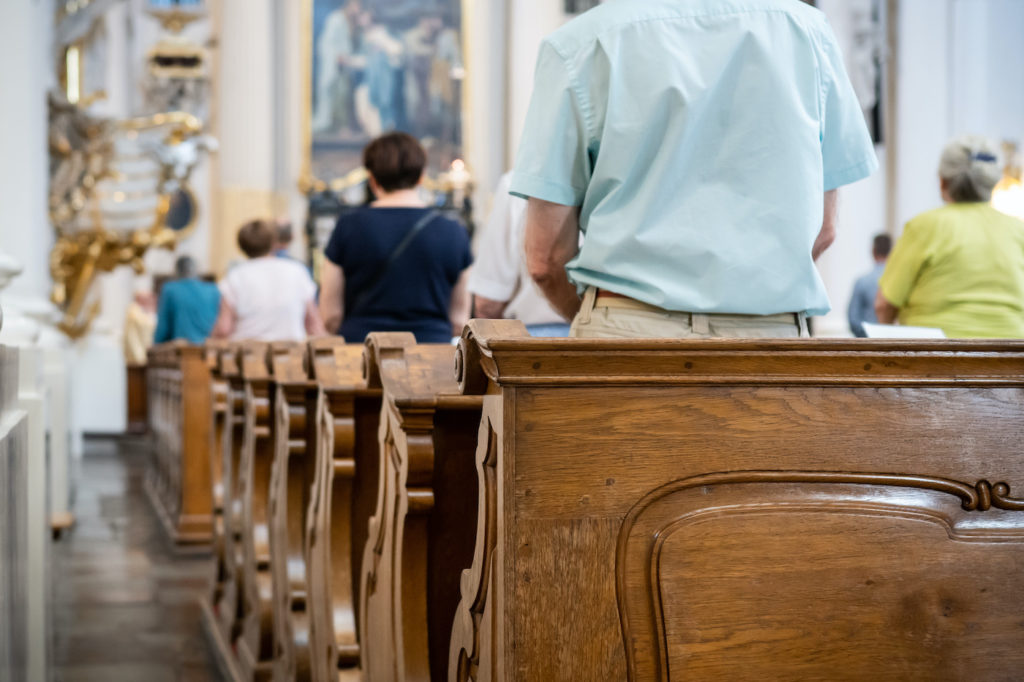“Synodality” is a confusing word that attentive Catholics are discussing these days, but its meaning is fairly mundane. “Synodality” refers to the active participation of all the faithful in the life and mission of the Church, while “synod” refers to a council or gathering of church leaders not unlike those in other Christian communions. In the Catholic Church, a synod is primarily composed of bishops, who deliberate about a particular matter or theme under the guidance of the Holy Spirit. In the present case, the October 2023 synod is about synodality itself—a deliberation about the nature of authority within the Catholic Church, an institution more associated with hierarchical than horizontal structures.
A central theme of the current papacy has been to bring about more lay involvement in the Church’s governance, and perhaps greater democratization, flexibility, and autonomy. Few dispute the first of these, though it makes some nervous. More, however, have misgivings about the latter trio and fear the German and Belgian bishops’ conferences will use the synod as a means to weaken the authority of central moral doctrines. What exactly Pope Francis thinks about all of this is not entirely clear.
An early and key part of the preparatory phase of this synod was a massive “listening and discerning” data collection effort across the globe, in an attempt to gauge the sensus fidei, or the “sense of the faith” (among the faithful). As a sociologist of religion and family, I was naturally interested. The fruit of this process is now summarized—or rather, synthesized—in the Document for the Continental Stage. The DCS is the Vatican’s interpretation of the data and a document that will be the focus of the seven “continental” meetings scheduled over the next few months. It serves as a precursor to the instrumentum laboris (or working paper) that the October 2023 synod’s participants will discuss and debate. In other words, it’s an important document. I also refer to it as the “Frascati report,” because it was the product of two weeks’ worth of work in late September by its authors at a retreat center in Frascati, Italy, not far from Rome. It was there that a few dozen select interpreters—mostly theologians—were asked to “authentically” synthesize the national reports made by 112 participating episcopal conferences from around the world. Hence, it’s a powerful group.
Making sense of interview and focus-group data from a solitary parish is not a simple task. Add another 10,000 like it from across the globe and you have an impossible challenge.
Start your day with Public Discourse
Sign up and get our daily essays sent straight to your inbox.Inquiring and listening are always good things, I maintain, and lay representation in Church governance merits some experimentation. After reading the DCS, however, I have grave concerns as a social scientist about the methodological mess that has characterized this synod’s massive, unwieldy data-collection-and-analysis venture. Making sense of interview and focus-group data from a solitary parish is not a simple task. Add another 10,000 like it from across the globe and you have an impossible challenge. Then ask for “syntheses” instead of summaries? What results is a very expensive, time-consuming set of interpreters’ personal opinions, with little accountability (and no public access) to the original data.
Synthesis over Summary
If you really want to know the sensus fidei, generate a sample of nations, dioceses, and parishes; then field a brief, well-translated universal survey, add a few demographic markers, and include a few open questions. If you want to know what lapsed Catholics think, do the same. Outsiders? A similar process. But understanding the sensus fidei is not what the synod’s instructions appear to have sought. The Vademecum, used as a how-to guide for the data-collection phase, advised parish and diocesan teams to skip the summarizing in favor of “synthesizing,” described as “an act of discernment” that not only reports “common trends” but also “highlights those points that strike a chord, inspire an original point of view, or open a new horizon” in a manner that pays “special attention to the voices of those who are not often heard. . . .”
To be sure, even these local teams were tasked with the impossible—deliver a ten-page synthesis of what was heard. This was to be guided by two dozen questions, many of which were not even directed at what the “faithful” said, asked, hoped, or lamented. Among the queries are several more clearly aimed at the subjective experience of the writers:
- Overall, what were the fruits that the Holy Spirit has brought about through this experience?
- What steps does the diocese feel called to take in becoming more synodal?
- What cultural image(s) articulate(s) our experience of synodality?
Indeed, synthesizers at every level of the process have wielded considerable power to personalize their own sentiments. The Vatican’s DCS authors declared that theirs is not “the report of a sociological survey.” Instead, they considered it
a theological document in the sense that it is loaded with the exquisitely theological treasure contained in the experience of listening to the voice of the Spirit enacted by the People of God, allowing its sensus fidei to emerge.
I don’t see it. It seems, instead, a sensus marginis. What the Frascati group heard, or wrote down, is a great deal of woundedness and suffering. Are these the norm within the Church? Emotive terms saturate the document. For example, the word “feel” appears twenty-five times, including “[I]f the Church is not synodal, no one can really feel fully at home.” (What does this mean?) The term “dialogue” shows up thirty-one times, “discernment” twenty-eight times, “listening” thirty-eight times, “experience” forty-three times, “journey” thirty-three times, and versions of “welcoming” eighteen times. Exactly whose voices are these?
The methodological approach I took in The Future of Christian Marriage (Oxford, 2020) was rather different, drawing on interviews with nearly 200 Christian young adults from seven countries, almost all of whom professed faith and a measure of regular participation in congregational life. When I quoted interviewees, I always offered a variety of context—markers like age, sex (discernible from a pseudonym), religious tradition, marital status, and occupation—like a “28-year-old unmarried Pentecostal from Lagos,” a “27-year-old pharmacist and Maronite Catholic from Beirut,” or “a 27-year-old engineer working for a marketing company in Barcelona.” In the DCS, there is only a country identifier, which tells the reader next to nothing about the person offering the perspective. There is no context to the persons behind the snippets of a story—nothing to indicate they are young or old, male or female, rich or poor, married or unmarried, observant or alienated. Instead, selected quotes “were chosen because they express in a particularly powerful, beautiful or precise way sentiments expressed more generally in many reports.”
Empirically, the vagueness in the DCS is symptomatic of the use of participatory action research, a “method” of sorts that is light on rigor and heavy on fostering social change. Participatory action research, as one descriptive study characterizes it,
seeks to understand and improve the world by changing it. At its heart is collective, self-reflective inquiry that researchers and participants undertake, so they can understand and improve upon the practices in which they participate and the situations in which they find themselves.
This is not what John Henry Newman had in mind when he penned a treatise on the sensus fidei entitled Consulting the Laity in the Matter of Doctrine. A patron saint of misunderstood persons, Newman was mistakenly accused of having suggested that the bishops should be asking the laity for their advice, and endured years of suspicion over his motives. Consulting the faithful, Newman assured, was about listening, gathering facts, and gauging the health of the laity. It wasn’t about seeking direction. It was about understanding the mission.
Whither the Sensus Fidei?
Unlike in 1859, in 2023 there is ample evidence to wonder aloud about motives. The synodality process has been about far more than fact-finding. It has, contra Newman, sought to move boundaries. Suggestions of change saturate the DCS, but are strategically unspecific:
- “Careful and painful reflection on the legacy of abuse has led many synod groups to call for a cultural change in the Church . . .”
- “. . . the fundamentals of faith . . . do not change but can be moved and planted in ever new ground, so that the tent can accompany the people as they walk through history”
- “This is how many reports envision the Church: an expansive, but not homogeneous dwelling, capable of sheltering all, but open, letting in and out”
Remarks that imply an overhaul of Church teachings may be in order are numerous (for example, on the female diaconate, on access to the Eucharist, on LGBTQ matters, etc.). Alternatively, shifting the locus of authority may do the trick, as one comment from the archdiocese of Luxembourg urged: “The universal Church must remain the guarantor of unity, but Dioceses can inculturate the faith locally: decentralization is necessary.”
A dose of comeuppance was added at the end, when the press release about the Frascati group’s finished work was concluded and a copy of the DCS sent to all the Church’s bishops “as an act of restitution to the people of God.”
Susan Pascoe, a member of the Methodology Commission and a Frascati synthesizer, traveled to Bangkok in late October to press the DCS’s message to the Asian Bishops’ general conference. There she stated that the DCS “really is kind of a census of the church in the world.” No. A census is something in which everyone is supposed to participate, as even Luke’s Gospel makes clear. In a census, all participants provide information, there is no self-selection bias at work, and the results are summarized and reported, not “synthesized.” (And if a census isn’t possible, a representative sample is the next best thing.) But after multiple rounds of synthesis, the synod’s original data—what the people actually said—appear irrecoverable. The power to decide the sensus fidei instead lies with the interpreters at every stage, from the parish all the way to Frascati. In other words, the DCS is about as likely to convey the sensus fidei as it was originally conveyed as children are to successfully repeat phrases while playing “the telephone game.”
“We’re not inventing anything new,” asserts journalist, papal biographer, and Frascati participant Austin Ivereigh. And yet the Frascati group employed an “empty chair” at their meeting to symbolize “missing voices,” enabling them to inject further subjectivity. Did they? We have no idea. If the data were competently collected from a representative sample of the targeted population, then who the analysts are should not make much difference. But if the data come from a multi-stage, unrepresentative cluster sample of self-selected participants from an unclear target population, then who the data analysts are and what they intend means everything.
The DCS is about as likely to convey the sensus fidei as it was originally conveyed as children are to successfully repeat phrases while playing “the telephone game.”
Citing Pius IX’s concern for understanding the views of both clergy and lay people about the doctrine of the Immaculate Conception prior to elevating the matter to the status of dogma, Newman stressed the two together: “the Church teaching and the Church taught.” A little over one hundred years later, Lumen gentium, the Dogmatic Constitution on the Church, articulated the authority of the sensus fidei while clarifying that the laity does not comprise this alone:
The entire body of the faithful, anointed as they are by the Holy One, cannot err in matters of belief . . . when “from the Bishops down to the last of the lay faithful” they show universal agreement in matters of faith and morals (12).
The problem of the “Church taught” is particularly urgent. I can only speculate about how few of the faithful can define the Immaculate Conception, much less defend it. In the United States, for example, only 31 percent of American Catholics hold that “during Catholic Mass, the bread and wine actually become the body and blood of Jesus.” This alarming estimate prompted the U.S. Catholic Conference of Bishops to double down on educating Catholics about the doctrine—not pressing to change it. And so a National Eucharistic Revival was born. The problem affects moral theology as well. In nationally representative data collected in late 2018, 20 percent of American Catholics who had prayed the rosary within the past week agreed that “it should be okay for adolescents to ‘transition’ with hormones or surgery if they identify with another gender.” Another 26 percent of them didn’t know what to think about the issue. Comparable minorities were visible among weekly Mass attendees and the belief that viewing pornographic material is okay. Lapsed Catholics, meanwhile, display staggering levels of unorthodox belief and behavior in moral matters like these. For example, among Catholics who said they did not attend Mass on the Sunday (or vigil) prior to being administered the survey, fewer than 10 percent held that cohabiting before marriage was a bad idea. The problem is not with the “Church teaching” but with the “Church taught.” Indeed, early in the current pontificate, the International Theological Commission asserted that “authentic participation in the sensus fidei” is to be characterized by a series of behaviors and dispositions. While the Church is indeed called to the margins, it does not follow that the sensus fidei is located there.
Protecting the Deposit of Faith
Collectively, the DCS reads like a wish list of frustrated reformists who have shifted the preferential option away from the poor and toward “the young” and the culturally alienated (as section 35 details). The authors all but state that the Church is preventing the faithful from acting, constraining them by undemocratic structures, obstructing clergy, and a bald disregard for the marginalized. None of that is widely, consistently true. Nothing in Catholic social teaching prevents engaged Catholics from seeking to effect social and environmental justice in their communities and countries. Much has been done—in many episcopal conferences—to curb the self-inflicted scourge of clerical sexual abuse. And just as I’ve never encountered a priest who has made my confessional experience more akin to “a torture chamber” than “an encounter with the Lord’s mercy,” I am also unfamiliar with a Church that is not “inclusive, open and welcoming” (section 16).
I would caution against confidence that what the synod fathers start with—the product of unwieldy data in the hands of partial mediators—is stable ground for discerning divine intention, let alone the Good, the True, and the Beautiful.
As the continental phase proceeds, I have no idea what the emerging instrumentum laboris will look like, how the October 2023 and 2024 synods will proceed, and of what character, content, and tone the interim and final documents for them will consist. But I would caution against confidence that what the synod fathers start with—the product of unwieldy data in the hands of partial mediators—is stable ground for discerning divine intention, let alone the Good, the True, and the Beautiful. Let it instead be a guide for the mission field.
Pray, then—as one wise prelate did while unjustly jailed—for “the wisdom and courage of the bishops, who have to lead us out of the dark shadows into the light of Christ.” We may all be “journeying together,” but it is they who are our authority. They must “test everything; retain what is good” (1 Thess. 5:21).
Prudent Christian evangelization seeks to share what has been conserved. It is, as the epigram states, one beggar showing another beggar where the bread is. What harms the Church is not her deposit of faith. That is a treasure for which every beggar longs, including this one. What must adapt is not the story of her undying passion for souls, her recognition of the dignity of all, and her universal call to holiness. What must change, to paraphrase Chesterton, is me.














